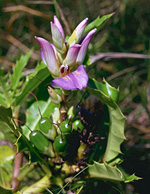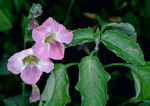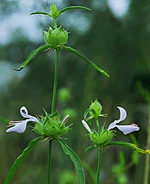 |
This large family is found throughout the tropics and subtropics of the world. In Australia, this is a principally a family of tropical savannahs and rainforests, although some genera extend to temperate woodlands and grasslands, and into arid Australia.
Characteristic features of the family Acanthaceae in Australia include: - herbs or small shrubs with opposite (rarely alternate) leaves
- cystoliths (small, often whitish or raised streaks) in the leaves and stems
- flowers tubular, usually zygomorphic and two-lipped, with four or two stamens inserted in the throat
- ovary superior, developing into a capsule with many seeds and specialised seed-stalks (jaculators) that throw the seed from the mature capsule
Description
Evergreen trees or shrubs, perennial terrestrial herbs, or rarely herbaceous vines climbing by twining stems, or aquatic herbs rooted in the substrate with their leaves emergent. If herbs then perennating by crowns or rarely tubers. Stems usually unarmed or rarely with thorns or spines arising from the leaf axils; internodes terete or distinctly angular. Internal secretions not obvious. Plants glabrous or with simple, glandular or non-glandular, unicellular or uniseriate hairs. Leaves opposite or rarely alternate and spiral, cauline or rarely mostly basal if herbs, sessile or petiolate. Stipules absent. Lamina simple, symmetric, filiform, acicular, subulate, linear, lanceolate, ovate, elliptic, oblanceolate, obovate or oblong; base cordate, attenuate, cuneate or rounded; margins entire, dentate or spiny; venation pinnate, with the midrib conspicuous, and the tertiary venation reticulate or not; surfaces rarely dark-punctate; herbaceous or rarely leathery. All flowers bisexual. Inflorescences terminal or axillary, consisting of spikes, racemes, panicles, cymes or solitary flowers. Bracts present. Bracteoles present or absent. Pollination by insects or birds. Flowers ?odourless; sessile or stalked. Floral disc present; nectaries present on the disc or rarely on the perianth. Perianth regular or irregular, of 2 dissimilar whorls, imbricate in bud. Calyx segments fused at least at the extreme base, with (2–) 4 or 5 lobes; calyx bell-shaped, herbaceous. Corolla segments fused, with 4 or 5 lobes, alternating with the calyx lobes; cup-shaped, funnel-shaped or tubular, 2-lipped, rarely 1-lipped, white, red, pink, purple, magenta, violet or blue, without contrasting markings, or streaked, spotted, etc.; membranous; lobes ±entire or notched, ranging from emarginate to shallowly or deeply 2- or 3-lobed, rarely more. Fertile stamens 2 or 4, opposite to the calyx lobes, at least partly fused to the corolla, distinct from each other, or fused by their filaments into an open or closed tube, rarely fused by their anthers, all ±equal or in 2 unequal pairs. Staminodes present or absent. Anthers dorsifixed, rarely versatile, opening inwards by longitudinal slits, rarely by basal pores; (1–) 2-celled; with appendages absent or basal. Ovary superior and sessile. Carpels 2, fused; ovary with 2 locules. Style terminal, single, unbranched or branched above. Ovules 1–numerous per locule, stalked; placentation axile. Fruit a dry loculicidal capsule, sometimes with explosive dehiscence; the perianth on the maturing fruit deciduous or dry and persistent. Disseminule macro-surface with straight hairs, or with mucilage when wetted; micro-surface ±smooth or tuberculate, brown, dull. Seeds 2–30 per fruit. Aril absent; funicular jaculator present. Cotyledons 2. Embryo straight, curved or sharply bent.(Note: this description has been generated from the coded data compiled for the key. Any errors in the key data will be reflected in the descriptions.)
A treatment of the family Acanthaceae has not yet been published in the Flora of Australia. It will appear in Volume 33.
Australian genera of Acanthaceae (as recognised for the
Flora of Australia)
† = some species native, others introduced
* = all species introduced
†Acanthus
*Andrographus
*Anisostachya
Asystasia
*Barleria
Brunoniella
Calophanoides
Dicladanthera
Dicliptera
Dipteracanthus
Ebermaiera
Graptophyllum
Hygrophila
Hypoestes
Isoglossa
Jacobinia
Justicia
Nelsonia
Peristrophe
Pseuderanthemum
Rhaphidospora
Rostellularia
Ruellia
*Rungia
Sarojusticia
Staurogyne
Stephanophysum
Strobilanthes
Thunbergia
Xerothamnella

|
  |

Acanthus ilicifolius (flowers and fruit)
Photo: D.Jones © D.Jones

Asystasia gangetica (flowers)
Photo: M.Fagg © ANBG

Dicliptera armata (flowers)
Photo: M.Matthews © ANBG

Dicliptera arnhemica (flowers)
Photo: M.Fagg © ANBG

|
 |
|